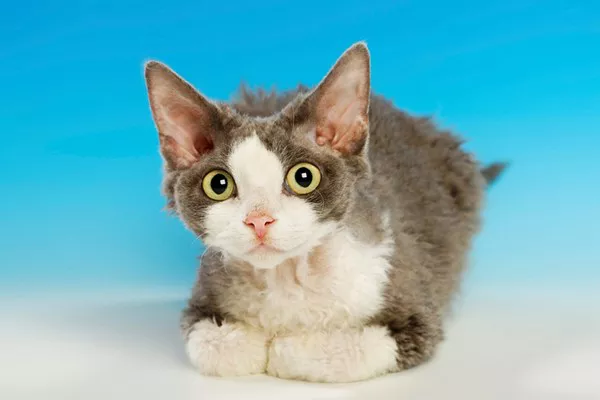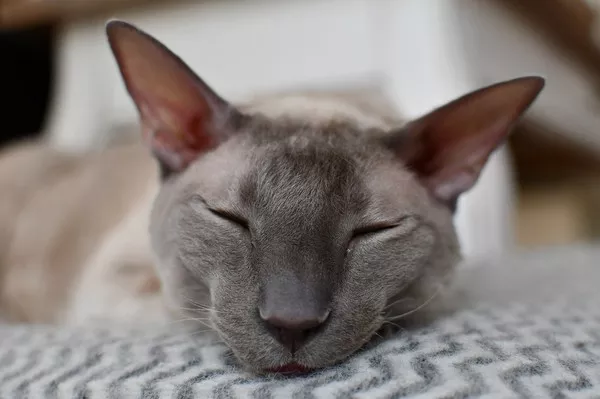The Devon Rex, a breed known for its slender body, wavy coat, and large, low-set ears, also captivates enthusiasts with its striking and varied eye colors. Understanding the eye color spectrum of the Devon Rex not only enhances the appreciation of their aesthetic appeal but also contributes to a broader understanding of feline genetics. This article delves into the various eye colors observed in the Devon Rex breed, explores the genetic mechanisms behind these colors, and discusses how these traits can impact health and breed standards.
Devon Rex
Before examining the eye colors of the Devon Rex, it is crucial to understand the breed’s origin and physical characteristics. The Devon Rex is a result of a natural mutation that occurred in Devonshire, England, in the late 1950s. The breed is distinguished by its soft, wavy fur, which is the product of a genetic mutation affecting the hair follicles. This mutation not only influences the coat but also has a role in the breed’s distinctive facial features, including its wide-set eyes.
General Overview of Feline Eye Color
Feline eye color is primarily determined by two factors: the pigmentation of the iris and the physics of light scattering within the eye. The pigment responsible for eye color in cats is melanin, and the density and distribution of melanin pigment granules in the iris stroma influence the color variation from light to dark and everything in between.
Genetics of Eye Color in Cats
The basic eye colors of domestic cats are typically green, yellow, or orange. These colors are influenced by multiple genes that regulate melanin production and distribution. A lesser amount of melanin results in lighter colors like green, whereas a higher concentration of melanin leads to deeper colors like copper or orange.
Unique Factors Influencing Devon Rex Eye Color
In the Devon Rex, the gene pool is somewhat limited due to the breed’s recent origin and the controlled breeding practices used to maintain its unique coat and body structure. This controlled genetic diversity can influence eye color patterns specific to the breed.
Exploring Devon Rex Eye Colors
The Devon Rex can exhibit a wide range of eye colors, typically vibrant and intense. The most common eye colors in the breed include:
Yellow and Gold
Yellow and gold are among the most prevalent eye colors in the Devon Rex. These colors result from a moderate concentration of melanin. The intensity of the color can vary significantly from light lemon shades to deep gold, depending on individual genetic expression and environmental factors.
Green
Green eyes in Devon Rex cats are captivating and can range from a bright lime green to a deeper emerald shade. Green eyes result from a lower concentration of melanin compared to yellow or gold and are often highly sought after due to their striking appearance.
Hazel
Hazel eyes occur less frequently and represent a mixture of light brown and green shades. This color is intermediate in melanin content and can vary widely in expression, sometimes appearing to change color under different lighting conditions.
Copper and Orange
The deepest eye colors seen in the Devon Rex are copper and orange, which indicate a high concentration of melanin. These eye colors are rich and intense, providing a stark contrast to the cat’s often lighter-colored coat.
Genetic Determinants of Eye Color in Devon Rex
The genetics of eye color in Devon Rex cats, as in other breeds, involves several genes that interact in complex ways. Key genes influencing eye color include:
OCA2 Gene: Primarily affects pigment production and distribution, influencing the depth of color.
TYR Gene: Affects tyrosinase, an enzyme crucial for melanin production, mutations in which can lead to color variations.
Polygenes and Environmental Influence
Besides single genes, polygenes (multiple genes that influence a trait) play a significant role in the variation of eye color. Environmental factors such as exposure to sunlight can also subtly alter the melanin concentration in the iris over time, potentially influencing eye color shade.
Impact of Eye Color on Health and Breed Standards
While eye color itself does not directly impact a cat’s health, certain genetic conditions related to pigmentation can be linked to health issues. For example, cats with very light-colored eyes may have a higher sensitivity to sunlight. In terms of breed standards, while the Devon Rex does not have specific requirements regarding eye color, vividness and clarity of color are generally preferred as they enhance the cat’s overall appearance.
Eye Color Changes Over a Cat’s Lifetime
It is also important to note that Devon Rex kittens are born with blue eyes, a common trait among many cat breeds. As they age, the eye color gradually changes, usually settling into the final adult color by the time they are three to six months old.
The Role of Eye Color in Breeding Practices
Breeding practices can influence eye color outcomes in offspring. Breeders often select mating pairs based on desirable traits, including eye color, to produce kittens that conform to certain aesthetic standards. This selective breeding can impact the genetic diversity of eye colors within the breed.
Conclusion
The eye colors of the Devon Rex range from the more common yellows and golds to the rarer shades of green and hazel, each adding to the mystique and allure of this unique breed. The intricate dance of genetics that determines these colors is a testament to the complexity of feline biology. For breeders, enthusiasts, and pet owners, understanding these principles not only enhances appreciation of the breed’s beauty but also guides responsible breeding and care practices. As research continues to unveil the secrets of feline genetics, the connection between eye color, health, and breed standards is likely to become even clearer, enriching our understanding and stewardship of the captivating Devon Rex.
























